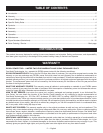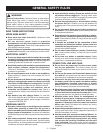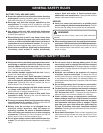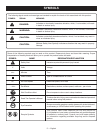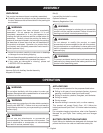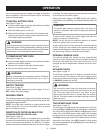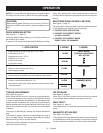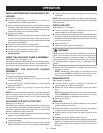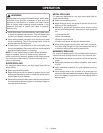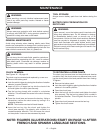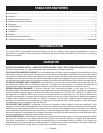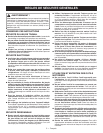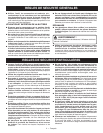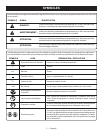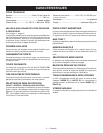
10 — English
Tighten the auxiliary handle assembly by turning the knob
clockwise.
NOTE: When properly installed, the teeth on the depth stop
rod should be aligned with the teeth indicator on the depth
stop rod clamp.
INSTALLING BITS
See Figures 14 - 15, page 16.
Lock the switch trigger by placing the direction of
rotation selector in the center position.
Open or close the chuck jaws to a point where the opening
is slightly larger than the bit size you intend to use. Also,
raise the front of the drill slightly to keep the bit from falling
out of the chuck jaws.
Insert the drill bit.
Tighten the chuck jaws on the drill bit.
WARNING:
Make sure to insert the drill bit straight into the chuck
jaws. Do not insert the drill bit into the chuck jaws at
an angle then tighten, as shown in figure 15. This could
cause the drill bit to be thrown from the drill, resulting
in possible serious personal injury or damage to the
chuck.
Rotate the chuck clockwise to tighten the chuck jaws
securely on the bit.
NOTE: Rotate the chuck body in the direction of the
arrow marked LOCK to tighten the chuck jaws. Do not
use a wrench to tighten or loosen the chuck jaws.
REMOVING BITS
See Figures 14, page 16.
Lock the switch trigger by placing the direction of
rotation selector in the center position.
Rotate the chuck sleeve clockwise to open the chuck
jaws.
NOTE: Rotate the chuck body in the direction of the arrow
marked UNLOCK to loosen the chuck jaws. Do not use
a wrench to tighten or loosen the chuck jaws.
Remove the drill bit.
DRILLING
Check the direction of rotation selector for the correct
setting (forward or reverse).
Secure the material to be drilled in a vise or with clamps
to keep it from turning as the drill bit rotates.
Hold the drill firmly and place the bit at the point to be
drilled.
Depress the switch trigger to start the drill.
Move the drill bit into the workpiece, applying only enough
pressure to keep the bit cutting. Do not force the drill or
apply side pressure to elongate a hole. Let the tool do
the work.
OPERATION
INSTALLING/REMOVING THE MAGNETIC BIT
HOLDER
See Figure 11, page 15.
Lock the switch trigger by placing the direction of
rotation selector in the center position.
Open or close the chuck jaws to a point where the opening
is slightly larger than the end of the magnetic bit holder.
Also, raise the front of the drill slightly to keep the bit
holder from falling out of the chuck jaws.
Insert the bit holder.
NOTE: Open the chuck jaws just enough to fully insert
the end of the magnetic bit holder. The body of the bit
holder should rest against the chuck jaws when the jaws
are closed and tightened.
Tighten the chuck jaws on the bit holder.
Insert a bit into the open end of the magnetic bit holder.
Tighten the chuck jaws on the bit holder.
To remove the magnetic bit holder, see
Removing Bits.
USING THE AUXILIARY HANDLE ASSEMBLY
See Figures 12 - 13, pages 15 - 16.
An auxiliary handle is packed with the drill for ease of opera-
tion and to help prevent loss of control. The handle can be
mounted on the opposite side for left or right hand use.
ADJUSTING THE AUXILIARY HANDLE
ASSEMBLY
See Figure 12, page 15.
To adjust the auxiliary handle assembly.
Loosen the handle assembly by turning the handle
counterclockwise.
Insert the auxiliary handle assembly in the desired
operating position.
Securely tighten by turning the auxiliary handle
clockwise.
NOTE: Be sure the auxiliary handle is securely tightened
against the depth stop rod clamp. This secures the depth
stop rod at the desired depth of cut. It also secures the
auxiliary handle.
ADJUSTING THE DEPTH STOP ROD
See Figure 13, page 16.
The depth stop rod helps control the depth of drilled holes.
For convenience and ease of starting threads, the hex nut
has been trapped inside the molded slot in the auxiliary
handle. To adjust the depth stop rod.
Lock the switch trigger by placing the direction of rotation
selector in the center position.
Loosen the auxiliary handle assembly by turning the knob
counterclockwise.
Adjust the depth stop rod so that the drill bit extends
beyond the end of the rod to the required drilling depth.



